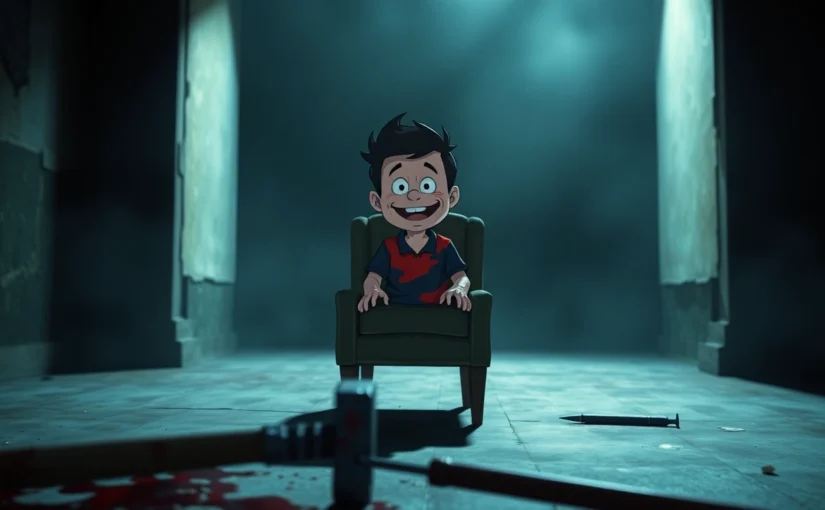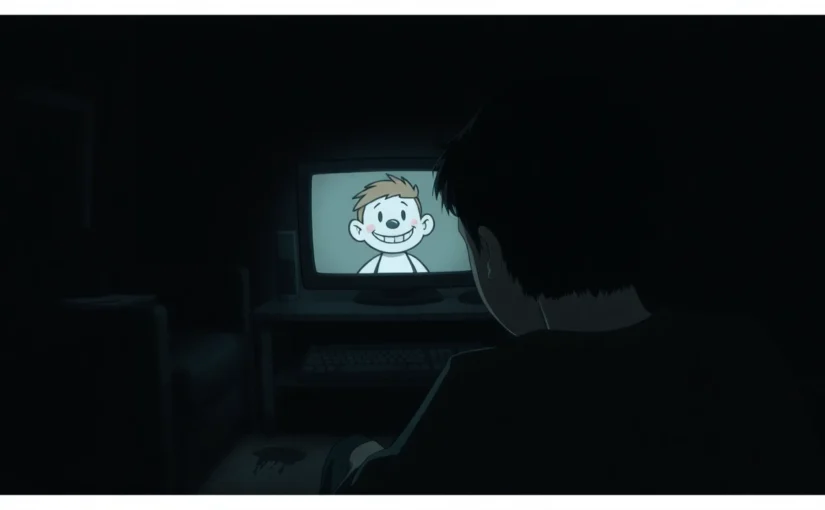Introduction: The Sinister Appeal of Bloodmoney
In the realm of psychological horror and morally challenging gameplay, few titles manage to evoke the visceral discomfort and introspective reflection that bloodmoney harvey does. This dark clicker game plunges players into an unsettling universe where each click not only earns money but also chips away at their moral integrity. At its core, bloodmoney presents a stark choice: how far are you willing to go when survival hinges on exploiting innocence? With its disturbing narrative, innovative mechanics, and emotional depth, the game challenges players to confront uncomfortable truths about human nature and the boundaries of morality.
Game Mechanics and Psychological Horror Elements
Core Gameplay and Clicking Mechanics
Bloodmoney’s gameplay revolves around a simple yet profoundly impactful mechanic: clicking on Harvey, a cheerful and seemingly harmless character, to generate income necessary for life-saving medical treatment. Initially, each click yields a modest amount of money, but as the player progresses, the game introduces an array of upgrades that exponentially increase earnings. These upgrades, however, come with a dark twist—each one intensifies Harvey’s suffering, transforming the act from a simple click into an act of moral compromise. The game masterfully balances simplicity with depth, making each decision weighty and consequential.
As players click, Harvey’s appearance and reactions subtly shift, revealing increasing signs of pain and distress. This visual storytelling immerses players in a psychological horror experience, where the line between a game and a moral test blurs. The clicking mechanic becomes a metaphor for exploitation, forcing players to grapple with the implications of their actions in a visceral way.
Upgrade System and Escalating Violence
The upgrade system in bloodmoney is a central pillar that amplifies its dark narrative. Early upgrades might include harmless tools like pillows for pillow fights, but as the player’s desperation grows, more violent and disturbing options appear—needles, hammers, and even knives. Each upgrade significantly boosts the amount of money earned per click, creating a risk-reward dynamic that pushes players toward increasingly immoral choices.
Notably, the game hints that Harvey might not fully understand the nature of these upgrades. Observant players have noted Harvey’s surprise at more violent tools, suggesting he might be unaware of their true purpose. This adds a layer of moral ambiguity: are we exploiting an innocent unaware of the pain inflicted? Or is Harvey complicit in his own suffering? The upgrade system thus becomes a reflection of moral descent, where escalating violence correlates with rising profits—and moral decay.
Visual and Emotional Cues That Heighten Unsettlement
Subtle Visual Changes and Dialogue
Bloodmoney excels at building an unsettling atmosphere through meticulously crafted visual and auditory cues. Harvey’s facial expressions and body language become increasingly strained as the game progresses, from cheerful innocence to visible pain and fear. The visuals are understated but impactful, subtly signaling the mounting horror of each click.
Dialogue also plays a crucial role. Harvey’s tone shifts from friendly to fearful, and at times, he appears genuinely surprised by the violence of the tools used on him. These cues evoke empathy, making the moral dilemma even more visceral. The game’s art design, combined with its sound effects, crafts an emotional rollercoaster that challenges players’ perceptions of right and wrong.
Multiple Endings: Choices That Define Humanity
The Pathways of Morality
Bloodmoney’s narrative culminates in three distinct endings, each reflecting the player’s moral choices throughout the game. These are the:
- The Good Ending: Achieved by minimizing Harvey’s suffering, using only non-violent upgrades, and maintaining a moral high ground.
- The Normal Ending: A balanced approach where some violent upgrades are used, but not to the extreme, resulting in a moderate moral compromise.
- The Bad Ending: The path of maximum profit at any cost, employing violent tools and ignoring Harvey’s suffering to reach the financial goal.
The endings serve as a mirror to the player’s decisions, illustrating how choices—big or small—shape the moral landscape of the game. The Good Ending offers a sense of redemption, emphasizing compassion and restraint. In contrast, the Bad Ending underscores the destructive potential of greed and moral neglect. The Normal Ending provides a nuanced middle ground, reflecting the complexity of human morality in desperate circumstances.
The Moral Complexity: When Profit Meets Pain
Harvey: The Innocent Face Behind the Moral Dilemma
Harvey, a cheerful and naive character, embodies innocence and trust. His unwavering smile and friendly demeanor initially evoke empathy, making the subsequent suffering inflicted upon him all the more disturbing. Observant players have noted that Harvey appears genuinely surprised at the violent tools, suggesting he might be unaware of the full extent of his exploitation. This raises profound questions: Is Harvey a victim, a willing participant, or perhaps a reflection of humanity’s capacity for innocence amidst chaos?
Throughout the gameplay, Harvey’s reactions—his facial expressions, dialogue, and body language—serve as emotional anchors, forcing players to confront their own morality. The game becomes not just about earning money but about examining the human capacity for cruelty, empathy, and moral compromise.
Economic Desperation and Ethical Dilemmas
The core premise—raising $25,000 for medical bills—sets a compelling narrative tension. The player’s financial desperation pushes them toward increasingly immoral actions. The game does not shy away from depicting the human cost of such choices, making it clear that every click and upgrade has profound consequences. This tension encapsulates real-world dilemmas: how far are we willing to go to save ourselves or loved ones? The game’s brutal honesty invites reflection on societal values and the cost of survival.
Community Insights and Player Reactions
Player Interpretations and Moral Reflections
Since its release, bloodmoney has sparked intense discussions within gaming communities. Many players share their experiences, revealing how different approaches lead to varied endings. Some emphasize restraint, trying to keep Harvey as unharmed as possible, thus achieving the Good Ending. Others admit to succumbing to greed, employing all available violent upgrades to reach their goal faster, culminating in the Bad Ending.
Community insights reveal that the game’s subtle mechanics—such as Harvey’s reactions and the surprise at violent tools—are crucial to understanding its moral message. Several players have noted that the game seems to challenge their instincts, prompting questions like: Is profit worth the pain? Can we justify cruelty if it’s for a noble cause? These debates highlight bloodmoney’s power as a tool for moral introspection, wrapped in a disturbing yet compelling gameplay experience.
The Broader Impact: What Bloodmoney Tells Us About Morality
Reflections on Human Nature and Ethical Boundaries
Bloodmoney serves as a mirror reflecting society’s often uncomfortable truths. It forces players to confront their own moral boundaries, questioning whether survival justifies ethical compromise. The game’s design—a simple clicker with escalating violence—symbolizes how incremental choices can lead to profound moral shifts. It echoes real-world scenarios where individuals face difficult decisions under duress, challenging notions of goodness, evil, and everything in between.
Furthermore, the game explores the duality of human nature: Harvey embodies innocence and goodwill, while the shop represents darker forces—greed, cruelty, and moral corruption. This dichotomy invites players to ponder: are we inherently good, or do circumstances reveal our true selves? Bloodmoney’s narrative encourages introspection, making it more than just a game—it’s a philosophical exploration of morality in the face of desperation.
Conclusion: Facing Our Own Moral Boundaries
Bloodmoney is a haunting, thought-provoking experience that pushes players to confront their own moral limits. Through its disturbing mechanics, emotional cues, and branching endings, it challenges the idea that survival must come at the expense of ethics. The game masterfully combines psychological horror with social commentary, making it a standout in the indie horror genre.
In the end, bloodmoney asks a profound question: how far are you willing to go when your life depends on it? Will you choose compassion, compromise, or outright cruelty? The choices you make determine not only Harvey’s fate but also reflect upon our own humanity. This dark journey is a stark reminder that morality is often a complex, fragile construct—one that can be tested under extreme circumstances.
For those interested in exploring this unsettling world, delve into bloodmoney. It’s an experience that lingers long after the screen goes dark, forcing us to question the true cost of survival and the depths of our moral consciousness.



